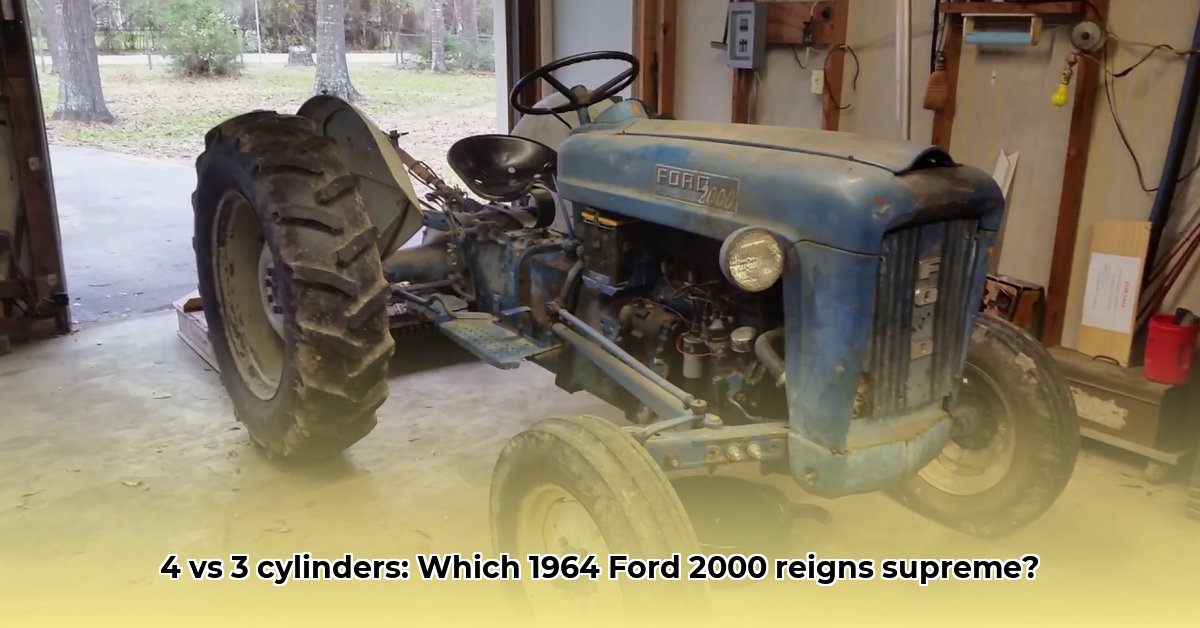
Understanding the Differences Between the 1964 Ford 2000 Tractor Models
The 1964 Ford 2000 tractor, a staple of agricultural machinery in the 1960s, came in two primary configurations: a 4-cylinder and a 3-cylinder model. While both bore the same name, significant differences in their engine, transmission, and hydraulic systems impacted their performance and suitability for various farming tasks. This detailed comparison examines these key distinctions, providing clarity for both enthusiasts and those requiring precise technical information. Why did Ford offer two such distinct models? The answer lies in providing options catering to diverse farming needs and budgets. For more Ford tractor info, see this helpful resource.
Engine Specifications: Power and Performance
The most striking difference lies under the hood. The 4-cylinder Ford 2000, offered initially in 1962, featured a larger engine displacement—2.2 liters for gasoline models and 2.4 liters for diesel. This resulted in a higher gross horsepower output of approximately 48.4 hp, making it a powerful workhorse ideal for heavy-duty applications. Conversely, the 3-cylinder model, introduced in 1965, used a 2.6-liter engine, generating around 39 hp. This difference, though seemingly small, translates to a notable discrepancy in power and torque, influencing the tractor's overall capabilities. Have you ever considered the impact of this horsepower difference on fuel efficiency? Initial reports suggest the smaller engine offered improved fuel economy.
Transmission Systems: Operational Differences
The transmission systems further highlight the differences between the two models. The 4-cylinder models provided a choice of synchronized transmissions with 4, 5, 10, or even 12 speeds. Synchronized transmissions offer smoother gear changes, enhancing operator comfort and efficiency. The 3-cylinder models, however, employed unsynchronized transmissions with 4, 6, 8, or 12 speeds. Unsynchronized transmissions require more skill and precision during shifting, leading to a less refined driving experience. This difference alone significantly impacts the overall usability and appeal of each tractor to different users.
Hydraulic Systems: Capacity and Pressure
Both tractor models utilized open-center hydraulic systems, but their capacity and operating pressure differed significantly. The 4-cylinder version featured a 2-gallon hydraulic system operating at 2000 psi. The 3-cylinder model, however, boasted a substantially larger 6.3-gallon system operating at 2500 psi. This greater hydraulic capacity and pressure allowed the 3-cylinder model to power a broader range of implements and handle more demanding tasks. How did this impact the performance on hilly terrain? Anecdotal evidence suggests the 3-cylinder model's higher pressure system provided a significant advantage in such conditions.
Comparative Specifications: A Quick Overview
The following table neatly summarizes the key differences between the two Ford 2000 models:
| Feature | 4-Cylinder Model | 3-Cylinder Model |
|---|---|---|
| Engine Size (liters) | 2.2/2.4 (Gas/Diesel) | 2.6 (Gas/Diesel) |
| Horsepower (hp) | ~48.4 | ~39 |
| Transmission | Synchronized; Multiple Speed Options | Unsynchronized; Multiple Speed Options |
| Hydraulic Capacity (gallons) | 2 | 6.3 |
| Hydraulic Pressure (psi) | 2000 | 2500 |
Identifying and Maintaining Your 1964 Ford 2000 Tractor
Distinguishing between the 4-cylinder and 3-cylinder Ford 2000 models is crucial for both repairs and maintenance. The key is to focus on understanding the distinct mechanical differences that dictate parts compatibility and servicing needs. Accurate identification is paramount, as using incorrect parts or repair manuals can lead to costly damage or even safety issues.
Visual Identification and Key Distinguishing Features
Several key visual differences help in identifying each model:
- Engine Configuration: The number of cylinders is the most obvious differentiator.
- Transmission Housing: Differences in the design of the transmission housings can provide clues for identification.
- Axle Housings: Variations in the shape and dimensions of axle housings can further aid identification.
- Hydraulic System Components: Observe the layout of the hydraulic system components for variations.
- Optional Equipment: Note any variations in the inclusion of additional features.
Model-Specific Maintenance and Repair
Accessing accurate model-specific information is crucial for successful maintenance and repairs. Using the incorrect manuals can result in costly mistakes, damage, and potential safety hazards. Always ensure you are using the correct service and parts manual for your specific Ford 2000 model and year. This holds true for all maintenance and repair activities.
Troubleshooting Common Issues: A Practical Approach
Common issues like malfunctioning tachometers or hydraulic leaks require model-specific solutions. Generalized repair guides or videos are often insufficient and may even lead to further complications. Utilizing the correct model-specific manuals is paramount for troubleshooting and resolving these issues effectively.
The 1964 Ford 2000 tractor, in both its 4-cylinder and 3-cylinder configurations, represents a significant piece of agricultural history. Understanding the nuances of these models ensures correct maintenance and appreciation of their distinct design philosophies.